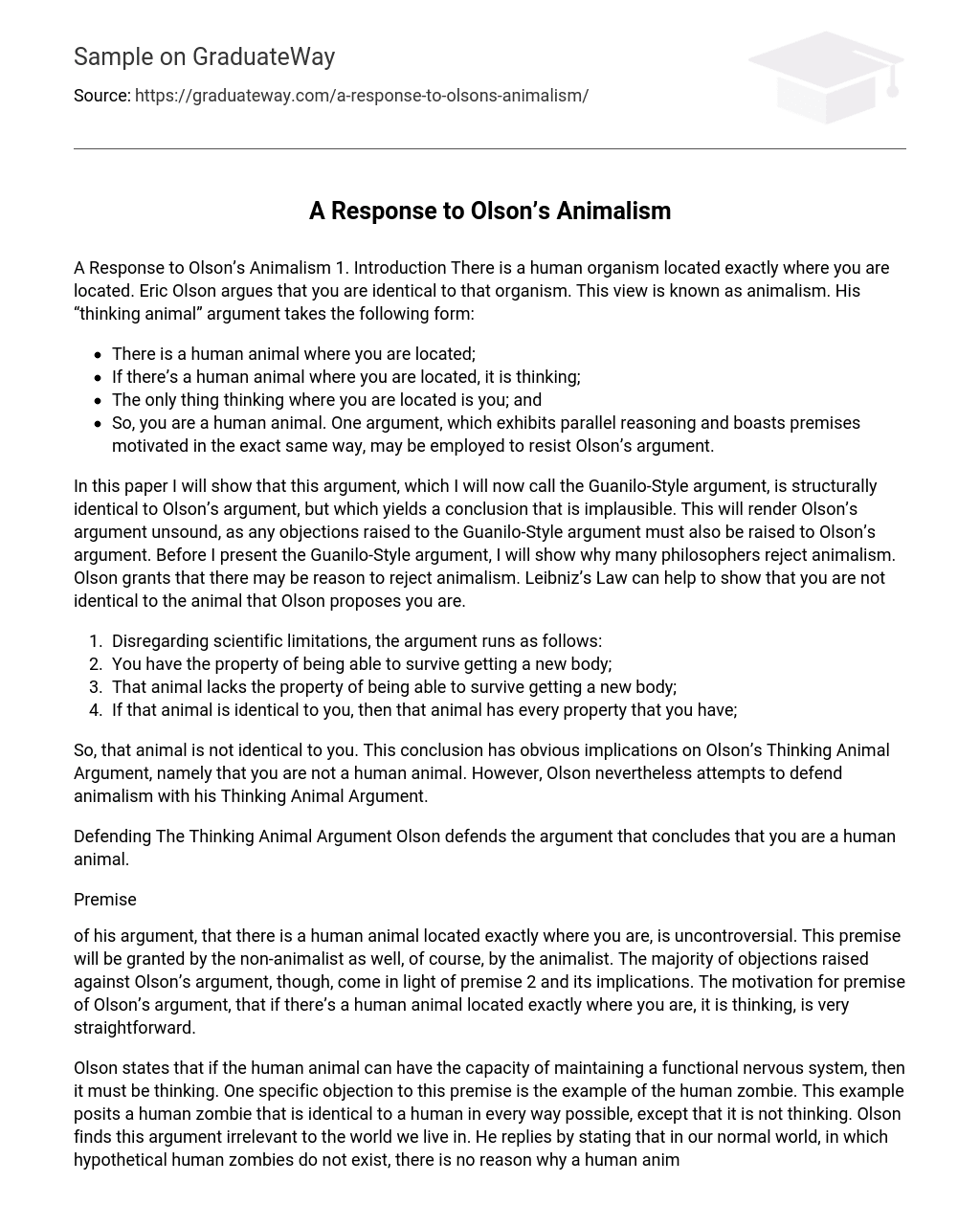A Response to Olson’s Animalism 1. Introduction There is a human organism located exactly where you are located. Eric Olson argues that you are identical to that organism. This view is known as animalism. His “thinking animal” argument takes the following form:
- There is a human animal where you are located;
- If there’s a human animal where you are located, it is thinking;
- The only thing thinking where you are located is you; and
- So, you are a human animal. One argument, which exhibits parallel reasoning and boasts premises motivated in the exact same way, may be employed to resist Olson’s argument.
In this paper I will show that this argument, which I will now call the Guanilo-Style argument, is structurally identical to Olson’s argument, but which yields a conclusion that is implausible. This will render Olson’s argument unsound, as any objections raised to the Guanilo-Style argument must also be raised to Olson’s argument. Before I present the Guanilo-Style argument, I will show why many philosophers reject animalism. Olson grants that there may be reason to reject animalism. Leibniz’s Law can help to show that you are not identical to the animal that Olson proposes you are.
- Disregarding scientific limitations, the argument runs as follows:
- You have the property of being able to survive getting a new body;
- That animal lacks the property of being able to survive getting a new body;
- If that animal is identical to you, then that animal has every property that you have;
So, that animal is not identical to you. This conclusion has obvious implications on Olson’s Thinking Animal Argument, namely that you are not a human animal. However, Olson nevertheless attempts to defend animalism with his Thinking Animal Argument.
Defending The Thinking Animal Argument Olson defends the argument that concludes that you are a human animal.
Premise
of his argument, that there is a human animal located exactly where you are, is uncontroversial. This premise will be granted by the non-animalist as well, of course, by the animalist. The majority of objections raised against Olson’s argument, though, come in light of premise 2 and its implications. The motivation for premise of Olson’s argument, that if there’s a human animal located exactly where you are, it is thinking, is very straightforward.
Olson states that if the human animal can have the capacity of maintaining a functional nervous system, then it must be thinking. One specific objection to this premise is the example of the human zombie. This example posits a human zombie that is identical to a human in every way possible, except that it is not thinking. Olson finds this argument irrelevant to the world we live in. He replies by stating that in our normal world, in which hypothetical human zombies do not exist, there is no reason why a human animal with a fully functional nervous system would not be thinking.
Another defense of premise compares humans to less advanced animal. This defense of premise runs as follows:
Less advanced animals can think (e. g. , apes, dogs); If they can think, then human animals can think; So, human animals can think. Premise of Olson’s Thinking Animal, that if there is a human animal located exactly where you are and thinking, it is you, also raises possible objections. For instance, the idea of “you” is very different for Olson than it is for a substance dualist.
We can imagine a scenario in which there is a human animal with a brain and you with a head that is thinking. In this case, there would be a duplication of mental states within the same physical space. However, Olson will deny this on account of his denial that heads exist at all. Despite, Olson’s argument in defense of these premises we can make an argument with reasoning which parallels that of the Thinking Animal Argument, but leads to an absurd conclusion: you are your head.
The Guanilo-Style Argument
It is certain that the logical validity of Olson’s argument cannot be questioned. So, rather than questioning this aspect of the argument, we can formulate a parallel argument whose premises are motivated in the exact same way as Olson’s. This argument, which we will call the Guanilo-Style argument would follow in such a way: There’s a head located in the region you’re in; If there’s a head located in the region you’re in, it’s thinking; You’re the only thinking thing located in the region you’re in; and If so, then you are your head.
Common sense intuitions tell me that I am not my head and that this is an absurd conclusion to draw. However, since the Guanilo-Style argument boasts premises that are motivated in the exact same way as Olson’s Thinking Animal Argument and as such possesses parallel reasoning, there is no reason to think that Olson’s argument is sound.
Conclusion
I have presented the Guanilo-Style argument, which rests on individually motivated premises that exactly parallel those of Olson’s Thinking Animal Argument. As such, any attempt to deny or object to the premises of the Guanilo-Style argument must be made against Olson’s argument as well. In addition, a revision of any individual premise of Olson’s argument must also be made to the Guanilo-Style argument. As a result, Olson’s Thinking Animal argument is unsound.





